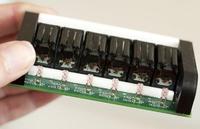-
FBI's Next Generation Identification launched
The FBI has launched its futuristic database — the Next Generation Identification (NGI) system); NGI will gradually replace the FBI’s Integrated Automated Fingerprint Identification System (IAFIS); this phase of the NGI project involves the core biometric processing and matching capability using ten fingerprints
-
-
Mexico violence boon to security garment industry

The deteriorating security situation in Mexico is a boon to the security industry; the Ninth Expo-Seguridad in Mexico City saw many companies offering bullet-proof garments — vests, scarves, shirts, and underwear — that protect against attacks with sharp objects; also on display was the more traditional personal protection gear such as helmets, gloves, goggles, and bullet-proof vests able to stop rounds from AK-47 and AR-15 assault rifles; one star of the show was Colombian businessman Miguel Caballero who is known for the bullet-proof jackets and vests he has produced for politicians, businessmen, and former presidents from across Latin America
-
-
New method for lifting latent fingerprints
A team of researchers at Nanjing University of Technology has developed a new process for especially rapid and simple detection of fingerprints; all it takes is a special nanofiber mat that is pressed onto the suspect surface and briefly treated with hot air — the fingerprints appear as red ridge patterns
-
-
Anti-counterfeiting solution maker expands scientific teams
According to a 2011 report published by the International Chamber of Commerce (ICC), global counterfeiting losses are forecasted to grow to as high as $1.7 trillion by 2017; the economic impact of this on the U.S. economy alone is estimated to be $775 billion per year; there is thus a growing demand for anti-counterfeiting solutions, including SigNature® DNA from Applied DNA Sciences; the company is expanding its forensic scientific group
-
-
Local police wear vests at all times to receive Justice funds
The Justice Department has said that it will withhold federal funding for local police departments to purchase body armor unless they make it a requirement that all uniformed officers wear the armor; last year, the Justice Department distributed $37 million to reimburse more than 4,000 local agencies across the country for the purchase of nearly 200,000 vests; the new requirement comes after a sharp increase in the fatal shootings of police officers while on duty; there was a 44 percent increase in the number of fatal police shootings last year and a recent study showed that 41 percent of police departments do not require officers to wear body armor
-
-
Spate of dry-ice bombs explosions in Long Beach, Calif.
A Long Beach officer is injured after an investigation of a dry-ice bomb left in an alley; a dry ice bomb is a homemade device that uses water, a bottle and dry ice, or frozen carbon dioxide; it can take anywhere from thirty seconds to an hour for a dry-ice bomb to rupture, depending on temperatures outside of the bottle
-
-
New FBI database improves accuracy, speed
Police across the United States can now compare prints to the much larger FBI database of seventy million prints in about ten minutes for a high-priority case, a half-hour for routine cases; civil fingerprint checks, such as those done for employment background screening, used to take twenty-four hours but can now be done in as little as fifteen minutes
-
-
Man smuggles 600 snakes, reptiles on bus
Acting on tip-off, police in Argentina searched the luggage of a bus passenger traveling from Santiago del Estero to Buenos Aires; the luggage contained 444 boas, vipers, and other snakes; 186 endangered tortoises; 40 lizards, and an armadillo
-
-
New Zealand company to offer personal jet packs
A New Zealand company has successfully tested a jet pack, and will soon make it commercially available for about £50,000; in tests, the pack, which weighs less than 254 pounds, traveled 30 miles in 30 minutes on a full tank of fuel; it reached heights of up to 2,400 meters and top speeds of 60 mph; the company said the pack could be perfect for the emergency services, private users, and even the military
-
-
Wastewater employee charged with terrorism after idling plant

A 43-year old waste water facility employee was the sole employee during the night shift at the massive Greenfield Water Reclamation Plant in Gilbert, Arizona; last Friday night, armed with a hand gun, the employee walked through the facility alone, methodically turning off major operating systems at the plant; left untreated, the sewage in the system would cause a buildup of methane gas, which could cause a huge explosion; after a 2-hour stand-off, the police arrested the man, allowing other employees to turn on the treatment systems; the employee is being held on a $250,000 bond, charged with terrorism
-
-
Austin police officers equipped with wearable cameras
For years, law enforcement has relied on dash cams to record what happens when officers step out of their vehicles; now, that technology is being upgraded to the next level in the form of body cams police officers can wear
-
-
Wisconsin to consider gun-tracking bill
Lawmakers in Wisconsin are circulating a bill that would revive efforts to require that all semi-automatic handguns sold in the state contain “micro-stamping” technology that allows police to link spent shell casings to gun buyers; similar legislation introduced in 2009 was heavily opposed by gun interests and never brought to a vote
-
-
New device uses sniffer bees to detect explosives

The unassuming honeybees have a hidden talent — an even keener sense of smell than anyone first expected — which could make them one of the U.K.’s most ruthless and worst-feared weapons against terrorism; researchers developed a portable handheld sensor that holds thirty-six trained bees gently restrained in six cassettes inside the device; each is taught to recognize a particular odor and associate that smell with a food reward; the researchers have already trained their honeybees to detect a wide variety of explosive compounds and mixtures, including Semtex, C4, PE4, TNT, DMNB, gunpowder, and hydrogen peroxide
-
-
Ultra-sensitive sensor technology detects explosives, cancer
Princeton researchers have invented an extremely sensitive sensor that opens up new ways to detect a wide range of substances, from tell-tale signs of cancer to hidden explosives; the sensor, which is the most sensitive of its kind to date, relies on a completely new architecture and fabrication technique developed by the Princeton researchers; the device boosts faint signals generated by the scattering of laser light from a material placed on it, allowing the identification of various substances based on the color of light they reflect; the sample could be as small as a single molecule
-
-
Oklahoma police to get wearable cameras
Police officers in Owasso, Oklahoma may soon all be wearing video cameras on their bodies; patrol cars already house cameras in their dash board to record a police officer’s actions, but the Owasso Police Department wants each of its thirty-nine agents to wear a camera at all times; the cameras are designed to increase transparency, accountability, and help stop “the constant litigation that police face on a basis, complaints, and false accusations” by providing undisputable video evidence of what occurred; the cameras will cost $900 per unit
-
More headlines
The long view
How Male Grievance Fuels Radicalization and Extremist Violence
Social extremism is evolving in reach and form. While traditional racial supremacy ideologies remain, contemporary movements are now often fueled by something more personal and emotionally resonant: male grievance.
